Shreveport, Louisiana Blood Testing Facilities
 Represents a LabCorp blood testing facility
Represents a LabCorp blood testing facility Represents a Quest Diagnostics blood testing facility
Represents a Quest Diagnostics blood testing facility
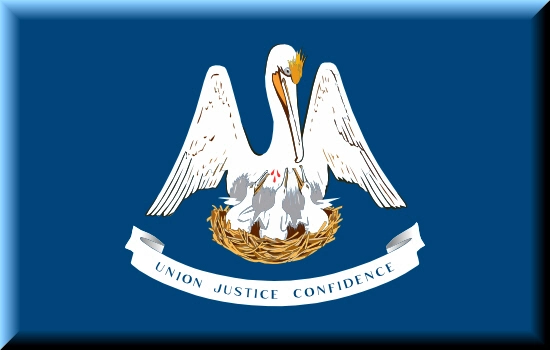
Nearby Labcorp Blood Testing facilities:
- Labcorp Center Distance: 3 m, 2920 Knight St Ste 108, Shreveport, Caddo Parish, LA, 71105
- Labcorp Center Distance: 55 m, 602 Hurst St, Center, Shelby County, TX, 75935
- Labcorp Center Distance: 57 m, 815 N 4Th St Ste D, Longview, Gregg County, TX, 75601
- Labcorp Center Distance: 67 m, 3505 Summerhill Rd Ste 3, Texarkana, Bowie County, TX, 75503
- Labcorp Center Distance: 79 m, 2001 S Main St, Hope, Hempstead County, AR, 71801
- Labcorp Center Distance: 91 m, 649 S. Broadway Ave Suite 1, Tyler, Smith County, TX, 75701
- Labcorp Center Distance: 93 m, 109 Circle Dr, West Monroe, Ouachita Parish, LA, 71291
- Labcorp Center Distance: 99 m, 800 Leslie St, Nashville, Howard County, AR, 71852
Nearby Quest Blood Testing facilities:
- Quest Center Distance: 0 m, 820 Jordan, Shreveport, Caddo Parish, LA, 71101-4519
- Quest Center Distance: 57 m, 603 N Second Street, Longview, Gregg County, TX, 75601-6441
- Quest Center Distance: 65 m, 921 Texas Blvd, Texarkana, Bowie County, TX, 75501-5163
- Quest Center Distance: 79 m, 403 W Oak St, El Dorado, Union County, AR, 71730-4575
- Quest Center Distance: 90 m, 822 S Fleishel Avenue, Tyler, Smith County, TX, 75701-2016
Louisiana Hormone Replacement Therapy Services
Are you 30 years or older and interested in the potential benefits that Hormone Optimization can offer to your life? Well, look no further! The Conscious Evolution Institute is one of the nation's premier providers of Quality HRT Services, and we are pleased to inform you that we serve all corners of Louisiana, from New Orleans to Shreveport!
By just giving us a call or filling out the form on our website, we can start you off on the path toward a new, revitalized, and optimized life!
Louisiana Low-T Treatments
Testosterone Deficiency is the most talked about form of Male Hormone Deficiency today, but most men still don't have a clear understanding of the impact that Low-T can have on a man's life. Everyone understands that Testosterone facilitates sexual activity, but far fewer people understand the long-term implications of Andropause (the clinical name for Age-Related Testosterone Deficiency).
Testosterone helps sustain the male body in peak shape and condition, and once Testosterone starts to lose its influence on the body, a number of symptoms can begin to manifest, including weight gain, anxiety, weakening muscles, increased cholesterol and triglycerides, slow metabolism, low libido, and sexual dysfunction.
The good news is that Testosterone Deficiency can be effectively treated with Testosterone Replacement Therapy! The Conscious Evolution Institute offers a number of forms of therapy, including Testosterone Topical Gels, Testosterone Injections, and Testosterone Patches.
Louisiana HGH Deficiency Treatments
Another form of Hormone Deficiency that effects both men and women is known as Age-Related HGH Deficiency (also known as somatopause). Human Growth Hormone is one of the most important hormones released by the human body, and after puberty, its primary purpose is to sustain optimal cellular metabolism.
So that means that HGH keeps us in peak condition. But around the age of thirty, our HGH Levels start to fade, which has a tremendous impact on our physiological condition over time. Growth Hormone Production drops at around 1-2% each year, at first unnoticeable, but eventually, undeniable.
Symptoms of HGH Deficiency include unhealthy changes in body composition, fatigue, loss of exercise capacity, depression, mood swings, memory and cognitive issues, reduced resistance to illness, and increased healing time from injury. Luckily, there are effective treatments for HGH Deficiency. The Conscious Evolution Institute offers both Sermorelin Acetate Therapy and HGH Injection Therapy, both are clinically proven to restore optimal Hormone Balance.
Louisiana HCG Injections
We also offer highly effective weight loss treatments, including HCG Weight Loss Therapy. Bio-Identical HCG is a medical treatment which has the ability to vastly improve the odds that your weight loss efforts are met with success.
When injected, HCG has a very unique effect upon the body. It encourages weight loss in three ways: It suppresses the sensation of hunger associated with a low-calorie diet, it directs the body to burn adipose fat tissue, and fat metabolism prevents the patient from struggling with fatigue.
If you are interested in HCG Therapy, we can help you lose 5 or more pounds each and every week!
Major Cities in Louisiana
New Orleans
New Orleans is one of the most important port cities in the United States, as well as one of the jewels of American cultural significance. New Orleans is also the most populous city in Louisiana, lying where the Mississippi River officially meets the ocean. New Orleans is referred to by many nicknames, including NOLA, The Big Easy, and The Crescent City.
The city is home to Tulane University, and also has a strong presence in pro sports, home of the New Orleans Saints and the Pelicans. The most famous location in New Orleans is undoubtedly Bourbon Street, where people come from all over the country to experience the non-stop party that the street represents. The biggest festival in New Orleans is Mardi Gras, the celebration of humanity that occurs in the week before lent.
Baton Rouge
Baton Rouge is the second most populous city in Louisiana, and is the capital of the state. Louisiana State University is also located in Baton Rouge, and the LSU Tigers are one of the most prominent college football teams in the nation. Baton Rouge goes by the nicknames The Capital City and the Red Stick.
The Baton Rouge economy revolves around a small number a powerful industries, including medical research and petrochemical research, manufacture, and production,. The largest employers of Baton Rouge are LSU, the public school system, Turner Industries, and the State of Louisiana. The oil industry is a strong sector of the Baton Rouge economy as well, and there is an ExxonMobil refinery located in the city, the second largest in the entire United States.
Shreveport
Shreveport is located in the northwestern portion of Louisiana, along the Red River. Shreveport is the third most populous city in Louisiana. Shreveport's nicknames include Shreve and Port City. Barksdale Air Force Base is also located just outside of the city, and is the largest employer of the city outside of the state itself.
Shreveport is known for its casinos and gaming, and is home to a number of Riverboat Casinos. Casinos in the area include Diamond Jacks Casino, Boomtown Casino, Horseshoe Casino, and Eldorado Casino. The city also has an entertainment and shopping complex known as the Louisiana Boardwalk.
Metairie
Metairie is the fourth most populous area of the state, but it is actually not a city, because it is not incorporated. In spite of that, it is a large and historically significant place. Metairie is located on the shore of Lake Pontchartrain, and is immediately to the northwest of New Orleans. Like New Orleans, Metairie also has a huge Mardi Gras celebration, but it bills itself as a more family-oriented experience, as opposed to the raucous New Orleans celebration.
Lafayette
Lafayette is located in the center of Louisiana, and is the fourth most populous city in the state, since Metairie is not a city. Lafayette was originally named Vermillionville when it was founded in 1821, but was renamed in 1884. Lafayette is also the heart of an area known as Acadiana, which is the home of the Creole culture in the United States.
The city is also the home of the University of Louisiana-Lafayette. The economy of the city centers on Information Technology and Manufacturing, and companies in the area include Presidio Networked Solutions, the Center for Business and Information Technologies, and CIS Hammers.
All About Shreveport, Louisiana Geographic Area
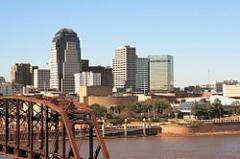
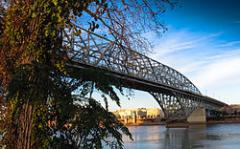
Shreveport /ËnÊcriËavpÉert/ is the third largest city in Louisiana and the 109th-largest city in the United States.
It is the seat of Caddo Parish and extends along the Red River (most notably at Wright Island, the Charles and Marie Hamel Memorial Park, and Bagley Island) into neighboring Bossier Parish. Bossier City is separated from Shreveport by the Red River. The population was 218,021 at the 2010 census, and the Shreveport-Bossier City Metropolitan Area population exceeds 400,000. The Shreveport-Bossier City Metropolitan Statistical Area ranks 117th in the United States, according to the United States Census Bureau.
Shreveport was founded in 1836 by the Shreve Town Company, a corporation established to develop a town at the juncture of the newly navigable Red River and the Texas Trail, an overland route into the newly independent Republic of Texas and, prior to that time, into Mexico.
Shreveport is the commercial and cultural center of the Ark-La-Tex, the area where Arkansas, Louisiana, and Texas meet. Many people in the community refer to the two cities of Shreveport and Bossier City as "Shreveport-Bossier".
Shreveport was established to launch a town at the meeting point of the Red River and the Texas Trail. The Red River was cleared and made newly navigable by Henry Miller Shreve, who led the United States Army Corps of Engineers effort to clear the river. A 180-mile (289 km) long natural logjam, the Great Raft, had previously obstructed passage to shipping. Shreve used a specially modified riverboat, the Heliopolis, to remove the logjam. The company and the village of Shreve Town were named in Shreve's honor.
Shreve Town was originally contained within the boundaries of a section of land sold to the company by the indigenous Caddo Indians in the year of 1835. In 1838 Caddo Parish was created from the large Natchitoches Parish and Shreve Town became the parish seat. Shreveport remains the parish seat of Caddo Parish today. On March 20, 1839, the town was incorporated as Shreveport. Originally, the town consisted of sixty-four city blocks, created by eight streets running west from the Red River and eight streets running south from Cross Bayou, one of its tributaries.
Shreveport soon became a center of steamboat commerce, mostly cotton and agricultural crops. Shreveport also had a slave market, though slave trading was not as widespread as in other parts of the state. Steamboats plied the Red River, and stevedores loaded and unloaded cargo. By 1860, Shreveport had a free population of 2,200 and 1,300 slaves within the city limits.
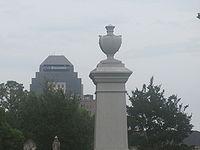
During the American Civil War, Shreveport was the capital of Louisiana from 1863 ae1865, having seceded, first, Baton Rouge, and then Opelousas after each fell under Union control. The city was a Confederate stronghold throughout the war and was the site of the headquarters of the Trans-Mississippi Department of the Confederate Army. Isolated from events in the east, the Civil War continued in the Trans-Mississippi theater for several weeks after Robert E. Lee's surrender in April 1865, and the Trans-Mississippi was the last Confederate command to surrender, on May 26, 1865. Confederate President Jefferson Davis attempted to flee to Shreveport when he left Richmond but was captured en route in Irwinville, Georgia.
Throughout the war, women in Shreveport did much to assist the soldiers fighting mostly far to the east. Accordingly, historian John D. Winters writes in The Civil War in Louisiana that:
"The women of Shreveport and vicinity labored long hours over their sewing machines to provide their men with adequate underclothing and uniforms. After the excitement of Fort Sumter, there was a great rush to get the volunteer companies ready and off to New Orleans...Forming a Military Aid Society, the ladies of Shreveport requested donations of wool and cotton yarn for knitting socks. Joined by others, the Society collected blankets for the wounded and gave concerts and tableaux to raise funds. Tickets were sold for a diamond ring given by the mercantile house of Hyams and Brothers...
A Confederate minstrel show gave two performances to raise money for the war effort in Shreveport in December 1862. The Shreveport Ladies Aid Society announced a grand dress ball for April 6, 1863. That same month students at the Mansfield Female College in Mansfield in De Soto Parish presented a vocal and instrumental concert to support the war.
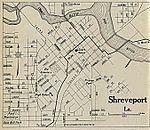
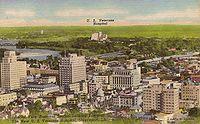
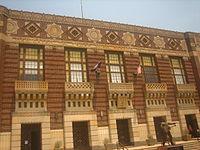
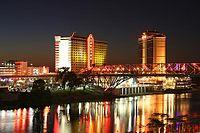
The Red River, which had been opened by Shreve in the 1830s, remained navigable throughout the Civil War. However, water levels got so low at one point that Union Admiral David Dixon Porter was trapped with his gunboats north of Alexandria by the lack of clearance. By 1914, disuse, along with the rise of the railroad, again resulted in the river becoming unnavigable. In 1994, navigability was restored by the United States Army Corps of Engineers with the completion of a series of lock-and-dam structures and a navigation channel. Today, Shreveport-Bossier City is again being developed as a port and shipping center.
By the 1910s, Huddie William Ledbetter aealso known as "Lead Belly", a blues singer and guitarist who eventually achieved worldwide fame aewas performing for Shreveport audiences in St. Paul's Bottoms, the notorious red light district of Shreveport which operated legally from 1903 to 1917. Ledbetter began to develop his own style of music after exposure to a variety of musical influences on Shreveport's Fannin Street, a row of saloons, brothels, and dance halls in the Bottoms. Bluesmen Jesse Thomas, Dave Alexander, and Kenny Wayne Shepherd and the early jazz and ragtime composer Willian Christopher O'Hare were all from Shreveport.
Shreveport was also home to the Louisiana Hayride radio program, broadcast weekly from the Shreveport Municipal Auditorium. During its heyday from 1948 to 1960, this program spawned the careers of some of the greatest names in American music. The Hayride featured names such as Hank Williams, Sr., and Elvis Presley, who made his broadcasting debut at this venue.
In 1963 headlines across the country reported that Sam Cooke was arrested after his band tried to register at a "whites-only" Holiday Inn in Shreveport. In the months following, Cooke recorded the civil rights era song, "A Change Is Gonna Come."
In 1969 the avant-garde band The Residents was probably formed in Shreveport.
The coming of riverboat gambling to Shreveport in the mid-1990s spurred a "revitalization" of the downtown and riverfront areas. Many downtown streets were given a facelift through the "Streetscape" project, where brick sidewalks and crosswalks were built and statues, sculptures, and mosaics were added. The Texas Street Bridge was lit with neon lights, that were met with a variety of opinions among residents.
Shreveport was named an All-American City in 1953, 1979, and 1999.
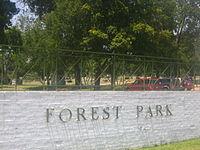
Shreveport sits on a low elevation overlooking the Red River. Pine forests, cotton fields, wetlands, and waterways mark the outskirts of the city.
Shreveport has a humid subtropical climate (Koppen climate classification Cfa). Rainfall is abundant, with the normal annual precipitation averaging nearly 47 inches (1.2 m), with monthly averages ranging from less than 3 inches (76 mm) in August to more than 5 inches (130 mm) in November. Severe thunderstorms with heavy rain, hail, damaging winds and tornadoes occur in the area during the spring and summer months. The winter months are normally mild, with an average of 35 days of freezing or below-freezing temperatures per year, with ice and sleet storms possible. Summer months are hot and humid, with maximum temperatures exceeding 90 degrees an average of 91 days per year, with high to very high relative average humidity, sometimes exceeding the 90 percent level.
The extreme temperatures range from na5 °F ( na21 °C) on February 12, 1899, to 110 °F (43 °C) on August 18, 1909.
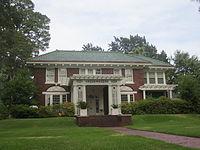
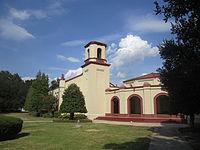
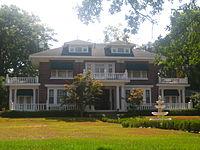
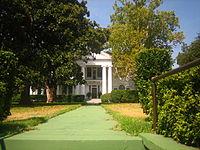
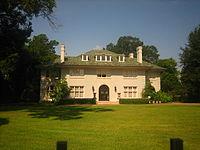

Shreveport encompasses many different neighborhoods and districts. Below is a list of the various areas in Greater Shreveport:
In the Highland section, along Fairfield Avenue, more than a half dozen homes have been designated as historic. These include residences once occupied by Lieutenant Governor of Louisiana Thomas Charles Barret, who served early in the 20th century; a Broadway director, Joshua Logan; a former governor and wife, Ruffin Pleasant; a physician and developer, George W. Robinson; a Coca Cola bottler, Zehntner Biedenharn; the first mayor of Bossier City, Ewald Max Hoyer, who took office in 1907; and a major real estate owner, John B. Slattery, whose home is one of five remaining structures in Shreveport designed by the noted architect N. S. Allen.
As of the 2010 census the population of Shreveport was 218,021. The racial and ethnic composition of the population was 41.2% white, 54.7% black or African American, 0.4% Native American, 1.3% Asian, 0.9% from some other race and 1.5% from two or more races. 2.5% of the population was Hispanic or Latino of any race.
As of the census of 2010, there were 218,021 people, 89,201 households, and 59,752 families residing in the city limits. The population density was 2,402.5 people per square mile (749.2/km ²). There were 92,012 housing units, at an average density of 841.6 per square mile (324.9/km ²). The racial makeup of the city was 50.80% African American, 46.66% White, 0.79% Asian, 0.31% Native American, 0.03% Pacific Islander, 0.45% from other races, and 0.95% from two or more races. Hispanic or Latino of any race were 1.55% of the population. From 1990 to 2000, the city's white non-Hispanic population declined from 53.6% to 45.9%, a -15% (-7 percentage point) decline. By 2004, among all groups, Shreveport gained 8.45% of its 2000 census population.
There were 91,501 households, out of which 30.1% had children under the age of 18 living with them, 38.3% were married couples living together, 21.5% had a female householder with no husband present, and 35.9% were non-families. 30.8% of all households were made up of individuals, and 10.9% had someone living alone who was 65 years of age or older. The average household size was 2.48 and the average family size was 3.12. Population ages ranked as follows: 26.9% under the age of 18, 10.7% from 18 to 24, 27.4% from 25 to 44, 21.1% from 45 to 64, and 13.9% who were 65 years of age or older. The median age was 34 years. The city ranks third in the nation of cities over 100,000 population with significant gender disparity: for every 100 females there were only 87.4 males, and for every 100 females age 18 and over, there were just 82.1 males. According to 2005 FBI statistics, Shreveport ranks 18th in overall crime rate among cities of 100,000-250,000 persons, with a murder rate of 19.6 per 100,000 population.
The median income for a household in the city was $30,526, 72.4% of the national median of $42,148, and the median income for a family was $37,126. Males had a median income of $31,278 versus $21,659 for females. The per capita income for the city was $17,759. About 18.7% of families and 22.8% of the population were below the poverty line, including 33.3% of those under age 18 and 16.3% of those age 65 or over.
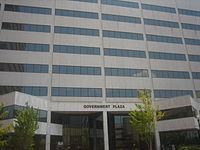
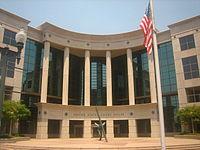
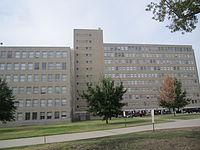
Founded in 1836 and incorporated in 1839, Shreveport is the parish seat of Caddo Parish. It is part of the First Judicial District, housing the Parish courthouse. It also houses the Louisiana Second Circuit Court of Appeal, which consists of nine elected judges representing twenty parishes in northwest Louisiana. A portion of east Shreveport extends into Bossier Parish due to the changing course of the Red River.
The city of Shreveport has a mayor-council government. The elected municipal officials include the mayor, Cedric Glover, and seven members of the city council. Glover, a former member of the Louisiana House of Representatives, is the first African American to hold the position. Shreveport became a majority black city in the 2000 census.
Under the mayor-council government, the mayor serves as the executive officer of the city. As the city's chief administrator and official representative, the mayor is responsible for the general management of the city and for seeing that all laws and ordinances are enforced.
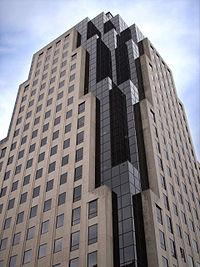
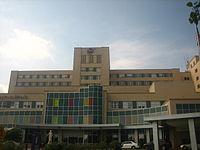
Shreveport was once a major player in United States oil business and at one time could boast Standard Oil of Louisiana as a locally based company. The Louisiana branch was later absorbed by Standard Oil of New Jersey. In the 1980s, the oil and gas industry suffered a large economic downturn, and many companies cut back jobs or went out of business, including a large retail shopping mall, South Park Mall, which closed in the late 1990s and is now Summer Grove Baptist Church. Shreveport suffered severely from this recession, and many residents left the area.
Today the city has largely transitioned to a service economy. In particular, the area has seen a rapid growth in the gaming industry, hosting various riverboat gambling casinos, and, before Hurricane Katrina in 2005, was second only to New Orleans in Louisiana tourism. Nearby Bossier City is home to one of the three horse racetracks in the state, Harrah's Louisiana Downs. Casinos in Shreveport-Bossier include Sam's Town Casino, Eldorado Casino, Horseshoe Casino, Boomtown Casino, and Diamond Jacks Casino (formerly Isle of Capri). The Shreveport-Bossier Convention and Tourist Bureau is the official tourism information agency for the region. The bureau maintains a comprehensive database of restaurants, accommodations, attractions, and events.
In May 2005, the Louisiana Boardwalk, a 550,000 square foot (51,000 m ²) shopping and entertainment complex, opened across the Red River in Bossier City, featuring outlet shopping, several restaurants, a 14 aascreen movie theater, a bowling complex, and a Bass Pro Shops.
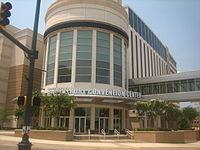
A new 350,000-square-foot (33,000 m2) convention center was recently completed in downtown Shreveport. It includes an 800 aaspace parking garage. An adjoining Hilton Hotel opened in June 2007. The city's direct construction and ownership of the Hilton Hotel has been a controversial issue as to the proper use of public funds. The Shreveport Convention Center is managed by SMG.
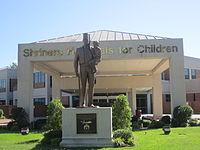
Shreveport is also a major medical center of the region and state. The Louisiana State University Health Sciences Center Shreveport operates at expanded facilities once used by the former Confederate Memorial Medical Center. Major hospitals include Christus Schumpert, Willis Knighton, and the Shriners Hospital for Children.
As of November 2008, the recent excitement about the Haynesville Shale has been a boom to Shreveport and the surrounding areas. Many new jobs in the natural gas industry are expected to be created over the next few years and local residents are enjoying large bonuses for signing mineral rights leases up to $25,000 per acre. However, the recent economic downturn has resulted in a lower market price for natural gas and slower-than-expected drilling activity. The city itself stands to profit by leasing the mineral rights on public lands in the near future as neighboring municipalities have already done.
Shreveport was home to Shreveport Operations, a General Motors plant that closed in August 2012. The plant produced the Chevrolet Colorado, GMC Canyon, and the Isuzu i aaSeries.
According to the City's 2009 Comprehensive Annual Financial Report, the top employers in the metropolitan area are:
Tax incentives offered by the state government have given Louisiana the third largest film industry in the country, behind California and New York, and led to Louisiana's nickname, "Hollywood South". Shreveport is no exception and has seen a number of films made in the city. Facilities include sound stages, the State Fair of Louisiana Fairgrounds Complex, and the Louisiana Wave Studio, a computer-controlled outdoor wave pool.
Selected films shot in Shreveport include:
Additionally, episodes of several television series have been shot in Shreveport and the surrounding area, including The Unit, True Blood, and The Gates.

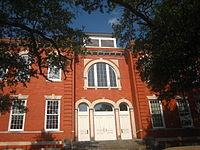
Caddo Public Schools is a school district based in Shreveport. The district serves all of Caddo Parish. Its founding superintendent was Clifton Ellis Byrd, a Virginia native, who assumed the chief administrative position in 1907 and continued until his death in 1926. C.E. Byrd High School, which was established in 1925 on Line Avenue at the intersection with East Kings Highway, bears his name.
Shreveport has several colleges, including the Methodist-affiliated Centenary College (founded at Jackson, Louisiana, in 1825; relocated to Shreveport in 1908) and Louisiana State University at Shreveport, which opened as a two-year institution in 1967. It became four-year in 1976. Louisiana State University Health Sciences Center Shreveport, the only medical school in northern Louisiana, opened in 1969. Shreveport also has one of the largest nursing schools in northern Louisiana, the Northwestern State University College of Nursing.
Southern University, Shreveport (SUSLA), offers a two-year associate's degree program. (The four-year institution, which is historically black, is in Baton Rouge.)
Founded in 1973, Louisiana Baptist University and Theological Seminary is also located in Shreveport at 6301 Westport Avenue.
Ayers Career College is a Shreveport based college that offers career training in the medical and HVAC fields.
Since July 2007, Shreveport is home to a local Remington College campus. This location offers both diploma and degree programs, and is active in the Shreveport Community.
Virginia College is a new college that opened early 2012. Located in Shreveport/Bossier City, Virginia College offers career training in areas such as Business and Office, Health and Medical, and Medical Billing.

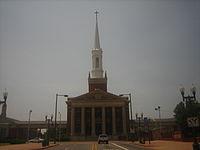
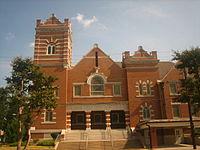
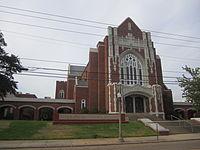
Shreveport has churches of many denominations and sizes. At the head of Texas Street is the large First United Methodist Church, established at that site in 1884. The current sanctuary dates to 1913. The church is pastored by Pat Day. Among its former pastors were D. L. Dykes, Jr., and John E. Fellers. The fiberglass steeple of the church fell onto a passing car during a severe thunderstorm in 2009, and has yet to be replaced.
A second Methodist congregation is named for J. S. Noel, Jr. The church was begun as a mission in 1906. Methodist layman James Noel and his wife, Fannie, provided financially for the church in its early years. The congregation decided to name the church for the Noel's late son. Like First United Methodist, it opened in the current sanctuary in 1913 and grew rapidly. A fire gutted the building in 1925, and only a portion of the loss was covered by insurance. The members expanded their ranks and rebuilt at the 500 Herndon location. The current Noel Memorial pastor is Flint Shea.
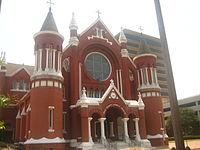
The large Holy Trinity Catholic Church located downtown was founded in 1858. Five priests died of yellow fever in 1873. The current sanctuary in Romanesque revival style architecture dates to 1896.
A large First Baptist Church was once pastored by Monroe E. Dodd, an early radio minister and founder of the former Dodd College for Girls. Former Governor Jimmie Davis, a Shreveport city commissioner too, taught history for a year under Dodd's tutelage. Other large Baptist congregations include Calvary Baptist, Broadmoor Baptist, and Summer Grove Baptist. The last was previously pastored by Wayne L. DuBose, now a Baptist denominational officer. Westview Christian Church is an independent Christian church that serves the area as well with members from diverse denominational backgrounds.
Shreveport is also home to Shreveport Community Church, a non-denominational church formerly belonging to the Assemblies of God doctrine. The congregation has experienced exponential growth from the 100 members in 1950 to more than 6,000 it claims now. It is pastored by Denny Duron, who succeeded his father, Rodney Duron after 45 years at the pulpit. The church also has an education program in Evangel Christian Academy, a pre aaK through 12th grade private school that has produced an average of 1 million dollars of scholastic scholarships for its graduating seniors every year. The church has also produced a biblical musical, "Songs of the Season", during the Christmas holidays for the past 20 years at the Historic Strand Theater in downtown Shreveport.
Particularly striking in size and architecture is St. Mark's Cathedral, an Episcopal congregation at 908 Rutherford Street in the Highland section of Shreveport. St. Mark's dates its establishment to the first religious service held in Shreveport in 1839.
The Jewish community dates to the organization of Congregation Har El in 1859, which later became B'nai Zion Temple, today the city's Reform congregation and largest synagogue. Agudath Achim, founded in 1905, as an Orthodox congregation is today a traditional Jewish synagogue. Rabbi Foster E. Kawaler, the current rabbi, is focused on rebuilding the congregation, which dwindled in size during the second half of the twentieth century. Shreveport, historically, has had a large and civic-minded Jewish community and has elected three Jewish mayors.
Shreveport and Bossier City shared an Arena Football League team named the Bossier-Shreveport Battle Wings and a Central Hockey League team, the Bossier-Shreveport Mudbugs, during the late 1990s and the 2000s. However, both teams shut down operations in 2010 and 2011.
Shreveport and Bossier City now share an all women's flat track roller derby team named the Twin City Knockers. The team is the newest competing sport in the area being founded in January 2010.
Baseball in Shreveport has an extensive past. The current team is a Minor League Baseball team known as the Shreveport-Bossier Captains. Baseball teams in Shreveport have gone through eight different name changes and seven different leagues all since 1895.
Shreveport's rugby team, the Shreveport Rugby Football Club, was founded in 1977, making it the oldest continuously competing sport team in Shreveport. It is a member of USA Rugby and participates in the Texas Rugby Football Union.
Shreveport is the home of the Shreveport Aftershock of the Independent Women's Football League. The Aftershock play in the Midsouth Division of the Eastern Conference of the IWFL. The home field for the Aftershock is Independence Stadium.
Shreveport had an expansion team of the defunct World Football League known as the Shreveport Steamer in 1974. They played at State Fair Stadium (now known as Independence Stadium) from September 1974 through October 1975. The Steamer were originally the Houston Texans before moving to Shreveport in September of 1974. In their inaugural season they had a record of 7 aa12 aa1. They went 5 aa7 in their final season in 1975. Shreveport also hosted a Canadian Football League football team in the mid-1990s known as the Shreveport Pirates. Bernard Glieberman, a Detroit real estate developer, was owner of the Ottawa Rough Riders of the CFL. In 1994, he sold the team and purchased the expansion franchise that ultimately wound up in Shreveport. He was allowed to take a handful of Ottawa players with him, including quarterback Terrence Jones. However, the Pirates became yet another unsuccessful American CFL team. Their first victory did not come until the 15th week of their initial season, and in 1995, all their victories came against Canadian teams. By 1996 the team had folded.
Shreveport is the birthplace, home, or former home of several American football stars and other noteworthy sports figures, among them:
Shreveport was mentioned as a potential city to house the NFL's New Orleans Saints in 2005 after Hurricane Katrina. It was passed over in favor of the much larger San Antonio and Louisiana State University in Baton Rouge, though the Saints ended up remaining in New Orleans. The Saints did play a game in Shreveport against the Dallas Cowboys during the 2006 NFL preseason.
Shreveport's Independence Stadium has served as host of the Independence Bowl since 1976. The stadium is also the home of the Port City Classic which started in 2010 when Louisiana Tech University defeated Grambling. Also Independence Stadium is the 3rd largest stadium in Louisiana with a seating capacity of 61,000 people only behind the Mercedes-Benz Superdome of 72,000 and Tiger Stadium of 96,000 in Baton Rouge.
Shreveport is home to several theatres, museums, and performing arts groups including the following:
Mardi Gras celebrations in Shreveport date to the mid aa19th century when krewes and parades were organized along the lines of those of New Orleans. Mardi Gras in Shreveport did not survive the cancellations caused by World War I, however. Attempts to revive it in the 1920s were unsuccessful and the last Carnival celebrations in Shreveport for decades were held in 1927. Mardi Gras in Shreveport was revived beginning in 1984 with the organization of the Krewe of Apollo. The Krewes of Gemini, Centaur, Aesclepius, Highland, Sobek, Harambee, and others, followed during the next decade and a half. The first krewe to revive parading was Gemini in 1989. Today, Mardi Gras is again an important part of the cultural life of the Shreveport metropolitan area.
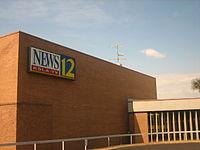
Shreveport is served by a variety of print publications. The major daily newspaper serving the Shreveport-Bossier and Ark-La-Tex area is the Shreveport Times. Its headquarters are located in downtown Shreveport near Interstate 20. A second major paper, the afternoon Shreveport Journal, ceased publication in 1991.
Other smaller non-daily newspapers in the area include The Shreveport Sun, the Caddo Citizen. Bossier City is served by the daily Bossier Press-Tribune. The Barksdale Warrior is the weekly newspaper of record for the Barksdale Air Force Base. In addition alternative publications include, The Forum Newsweekly, City Lights, and SB Magazine.
Twice annually, North Louisiana History, the journal of the North Louisiana Historical Association, is published in Shreveport.
Shreveport and Bossier City are served by two major cable television systems: Shreveport is served by Comcast and Bossier City is served by Suddenlink.
Shreveport is home to several radio stations, particularly KWKH and KEEL, having reputations beyond the city. The three commercial television outlets are KSLA-TV, CBS, founded in 1954; KTBS-TV, ABC, founded in 1955, and KTAL-TV, arrived in Shreveport in September 1961 as the NBC station. KTBS was an NBC station, with occasional ABC programs, from 1955 ae1961, when it switched affiliation to ABC. KTAL, formerly known as KCMC of Texarkana, was a CBS outlet prior to conversion to NBC, when it began to cover Shreveport as well as Texarkana. Don Owen (born 1930), a member of the Louisiana Public Service Commission from 1984 ae2002, is also a former news anchorman on KSLA.
Barksdale Air Force Base is located in Bossier Parish across the river from Shreveport, which donated the land for its construction in the 1920s. Named for pioneer army aviator Lt. Eugene Hoy Barksdale and originally called Barksdale Army Air Field, it opened in 1933 and became Barksdale Air Force Base in 1947. Headquartered here are the Air Force Global Strike Command, 8th Air Force, 2d Bomb Wing, and 307th Wing. The primary plane housed here is the Boeing B-52 Stratofortress. In earlier years, the base was the home to other famous planes, including the B-47 Stratojet.
Shreveport is home to the two 108th Cavalry Squadron, the reconnaissance element of the 256th Infantry Brigade. Three of the squadron's four cavalry troops are located at 400 East Stoner Avenue in a historic armory known as "Fort Humbug". This was named due to the Confederate Army burning logs to look like cannons and placing them along the Red River. This caused Union ironclad ships sailing north on the Red River to be tricked into turning back south.
Shreveport's past reflects the need for mass transit and public roads. As far back as the 1870s, residents used mule-drawn street cars that were converted to electric-motorized cars by 1890. Commuter rail systems in Shreveport flourished for many decades, and rail car lines extended out to rural areas. In 1930 trolleys and rail cars began to be replaced by buses, although motor buses did not finally replace all trolley service until the 1960s. In the 1960s, the Interstate Highway System came to the area with the construction of Interstate 20.
The local public transportation provider, SporTran, provides moderately extensive bus service throughout Shreveport and Bossier City. Sportran operates seven days a week on seventeen bus routes (five night routes) from 6:00 a.m. to 1:00 a.m., with no night service on Sunday.
Shreveport lies along the route of the proposed Interstate 69 North American Free Trade Agreement (NAFTA) superhighway that will link Canada, the U.S. industrial Midwest, Texas, and Mexico.
Shreveport is served by two airports. The largest is Shreveport Regional Airport (SHV), established in 1952, and is served by Allegiant Air (to Las Vegas), American Airlines (to Dallas/Ft. Worth), Continental Airlines (to Houston) and Delta Air Lines (to Atlanta and Memphis). The smaller airport, Shreveport Downtown Airport (DTN), was built in 1931 and is located north of the Downtown Business District along the Red River. It is currently a general aviation/reliever airport, but was originally Shreveport's commercial airport.
For Shreveport's notable sports figures, see separate list in "Sports" above.
In the late 1980s and early 1990s, John D. Carmack, John Romero, Adrian Carmack, and Tom Hall worked together at Softdisk, a computer company located in Shreveport. While working at Softdisk, these programmers developed technology which eventually led to the creation of Wolfenstein 3D and Doom. They later left Softdisk to form id Software in order to produce these games.
Word Count: 5662





